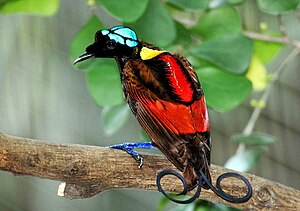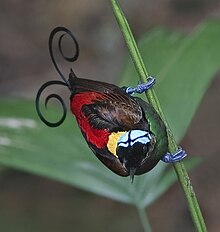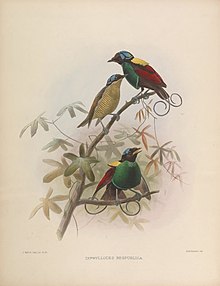Naked head bird of paradise
| Naked head bird of paradise | ||||||||||||
|---|---|---|---|---|---|---|---|---|---|---|---|---|

Bare-headed bird of paradise ( Cicinnurus respublica ) |
||||||||||||
| Systematics | ||||||||||||
|
||||||||||||
| Scientific name | ||||||||||||
| Cicinnurus respublica | ||||||||||||
| ( Bonaparte , 1850) |
The bare-headed bird of paradise ( Cicinnurus respublica , Syn . : Diphyllodes respublica ), also called blue-headed bird of paradise , is a very small species of bird from the genus Cicinnurus within the family of birds of paradise (Paradisaeidae). It only lives on the islands of Batanta and Waigeo off the coast of western New Guinea and occurs there at altitudes of up to 1200 meters.
The IUCN classifies the population of the bald headed bird of paradise as near threatened . No subspecies are distinguished.
features
Body type and measurements
The bare-headed bird of paradise reaches a height of 16 centimeters, including the middle pair of control springs, the males reach a body length of 21 centimeters. This makes them one of the smallest birds of paradise. The beak has a length of 2.3 to 2.8 centimeters. The males weigh between 53 and 67 grams. The females are almost equally heavy, weighing between 52 and 60 grams.
male
In the males, the crown and the neck are largely without feathers. The bare skin is bright blue. A fine, compact blue-black feather line that shines copper-colored runs across the top. The feathers on the lower neck are elongated and form a bright yellow collar, which contrasts strikingly with the deep crimson coat. This is bordered by a wide black line. The small wing coverts are black-brown with pale earth-brown edges. The large elytra are dark earth brown with fine crimson feather edges. The arm wings are black-brown with crimson-red feather hems on the outer flags, which do not quite reach the point of the feather. The arm wings are dark brown with very fine crimson feather hems on the outer flags. The rump and the upper tail-coverts as well as the upper side of the tail plumage are black-brown, only the middle control spring pair, which has developed into narrow sickles and is strongly bent outwards, is blue-violet and shines magenta in certain light conditions.
The chin and upper throat are velvet black with a copper to purple sheen. An oily, emerald-green, shiny plumage extends from the middle of the throat to the belly, which can shimmer blue-violet to red-violet in certain light conditions. Along the middle of the throat there are some feathers that, on the other hand, have a strong turquoise-blue sheen and the bottom row of the breast feathers has very shiny turquoise-green feathers. The rest of the underside of the body is earth brown with a dark purple sheen in certain light conditions. The beak is blackish, the inside of the beak is pale yellow. The iris is dark brown, the legs and feet are an intense blue.
Males not yet sexually mature are initially colored like the females, but usually already have individual feathers that correspond to the plumage of the male. The plumage of the adult males appears first on the head.
female
The females lack the central control feathers, which in the male are strongly bent outwards. The females and young birds have predominantly brown plumage on the upper side. Females, like males, have a bare, blue crown and neck. The rest of the head plumage is black-brown. The rest of the top of the body is dark olive, with the wings and tail plumage having a strong reddish-brown tint. The chin, the beard and the lower ear covers are cream-colored to light red-brown with fine gray spots. The rest of the underside of the body is pale red-brown with fine, even transverse bands. The legs and feet are a little darker than that of the males.
Distribution area and habitat
The naked head bird of paradise has only been observed on the islands of Waigeo and Batanta . The two islands belong to Raja Ampat , an archipelago in the Indo-Pacific west of New Guinea . It is east of the Moluccan island of Halmahera and northwest of the Vogelkop Peninsula of New Guinea. Batanta is in the east and Waigeo in the north of the archipelago. The Dampier Strait , a strait between the islands of New Guinea, Batanta and Salawati in the south and Waigeo and Gam in the north, separates the two islands.
The Nacktkopf-Paradiesvogel mainly inhabits the forests of the foothills. It is only rarely found in the rainforests of the lowlands or the mountain forests of these islands. On Batanta it is most common at an altitude of around 460 meters.
Way of life
The bare-headed bird of paradise lives mostly solitary or in mixed flocks with other songbirds. It feeds on fruits , insects and spiders . Captured locusts are carried by them to a raised hide, held there with one or both feet and freed from legs and wings before they are eaten. The males can already be heard in the early hours of the morning calling from singing stations.
Reproduction
Bare-headed birds of paradise are polygynous , which means that a male mates with several females whenever possible. The females raise the offspring alone.
Males show only on Balzplatz a territorial behavior . There are different details about the size of the courtship area. Some observers describe courtship sites with a diameter of half a meter to one meter. Other authors speak of a square that is about two to three meters tall. Similar to many of the bower birds , this mating area is cleared of disturbing plants and fallen leaves, so that the ground is uncovered. Sometimes leaves from adjacent trees are removed so that light can fall on the courtship area. Central to the mating area is a knotless tree sapling that has a diameter of about 3 centimeters at the bottom and is about 2.4 meters high. On this the male shows his blue spot, where the tail and breast plumage is presented.
The courtship behavior of bare-headed birds of paradise has already been filmed and was shown by David Attenborough in his nature programs for the BBC. A female triggers courtship behavior by landing on the tree sapling. The male, who usually sits further down on the vertical trunk of the sapling, initially only turns his head towards her and jerks it back and forth. The plumage has not yet bristled. If the female approaches him further, he pulls back the head and neck, ruffles the chest plumage and raises the tail plumage at an angle of 90 degrees. With all observed courtship the female flew into the surrounding branches. The male then rests the plumage smoothly again, but the tail plumage remains upwards. The head and beak continue to point to the female. If the female then returns to the tree sapling, the male ruffles his plumage again. The courtship behavior has not yet been observed. It is possible that, similar to the sickle- tailed bird of paradise, further courtship elements follow from the male of the bare-headed bird of paradise .
Nests of bare-headed birds of paradise had not been scientifically described until the end of the 20th century. There is also no information available about egg size, egg color, incubation period and nestling time.
attitude
The bare-headed bird of paradise has already been kept in zoological gardens on various occasions. The courtship elements described above have been observed in both London Zoo and Chester Zoo . Offspring have not yet succeeded.
etymology
The ornithologist and first describer Charles Lucien Bonaparte , a nephew of Napoleon and Republican , gave the following reason for naming this bird:
“There are people who try to name their most beautiful species with the name of princes: since I cannot show any respect for the authority of all the princes of the world, I have adorned this beautiful bird of paradise with the name of the Republic; that republic, which would be a paradise, would not be turned into a hell by the evil machinations and ambitions of so-called republicans, who are not worthy of the name. But since there should be no paradisiacal republic, there is now at least a Paradisea respublica , a republican bird of paradise. "
literature
- Bruce M. Beehler , Thane K. Pratt: Birds of New Guinea; Distribution, Taxonomy, and Systematics. Princeton University Press, Princeton 2016, ISBN 978-0-691-16424-3 .
- Clifford B. Frith, Bruce M. Beehler : The Birds of Paradise - Paradisaeidae. Oxford University Press, Oxford 1998, ISBN 0-19-854853-2 .
- Eugene M McCarthy: Handbook of Avian Hybrids of the World. Oxford University Press, Oxford 2006, ISBN 0-19-518323-1 .
- Thane Pratt, Bruce M. Behhler: Birds of New Guinea. Princeton University Press, Princeton & Oxford, 2nd Edition, 2015, ISBN 978-0-691-09563-9 .
Web links
Individual evidence
- ↑ Thane & Beehler (2015), p. 236
- ↑ Handbook of the Birds of the World on the Naked Head Bird of Paradise , accessed on July 18, 2017
- ↑ a b c Frith & Beehler: The Birds of Paradise - Paradisaeidae . P. 403.
- ↑ Frith & Beehler: The Birds of Paradise - Paradisaeidae . P. 401.
- ↑ a b Thane & Beehler (2015), p. 484
- ↑ Frith & Beehler: The Birds of Paradise - Paradisaeidae . P. 404.
- ↑ a b Frith & Beehler: The Birds of Paradise - Paradisaeidae . P. 405.
- ↑ a b Frith & Beehler: The Birds of Paradise - Paradisaeidae . P. 406.

